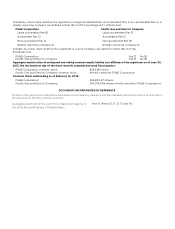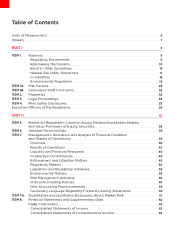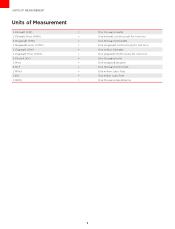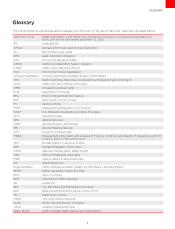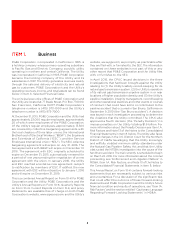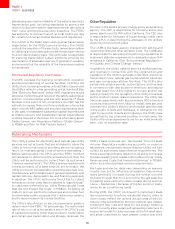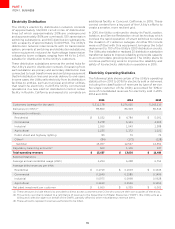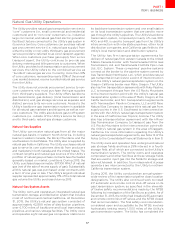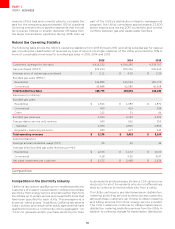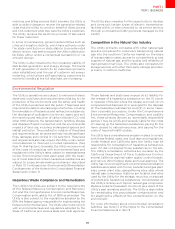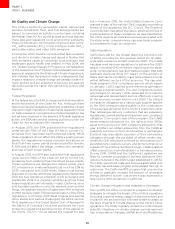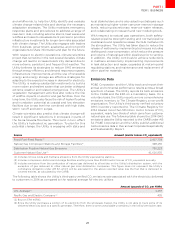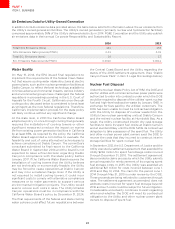PG&E 2015 Annual Report Download - page 20
Download and view the complete annual report
Please find page 20 of the 2015 PG&E annual report below. You can navigate through the pages in the report by either clicking on the pages listed below, or by using the keyword search tool below to find specific information within the annual report.
12
PART I
ITEM1.BUSINESS
California law allows electric utilities to recover the
costs incurred in compliance with their CPUC-approved
electricity procurement plans without further after-the-
fact reasonableness review by the CPUC. The CPUC may
disallow costs associated with electricity purchases if the
costs were not incurred in compliance with the CPUC-
approved plan or if the CPUC determines that the utility
failed to follow the principles of least-cost dispatch.
The Utility recovers its electricity procurement costs
annually primarily through the energy resource recovery
account. (See Note 3 of the Notes to the Consolidated
Financial Statements in Item 8.) Each year, the CPUC
reviews the Utility’s forecasted procurement costs related
to power purchase agreements, derivative instruments,
GHG emissions costs, and generation fuel expense, and
approves a forecasted revenue requirement. The CPUC may
adjust the Utility’s retail electricity rates more frequently
if the forecasted aggregate over-collections or under-
collections in the energy resource recovery account
exceed 5% of its prior year electricity procurement and
utility-owned generation revenues. The CPUC performs
an annual compliance review of the transactions recorded
in the energy resource recovery account.
The CPUC has approved various power purchase
agreements that the Utility has entered into with third
parties in accordance with the Utility’s CPUC-approved
procurement plan, to meet mandatory renewable
energy targets, and to comply with resource adequacy
requirements. For additional information, see “Electric
Utility Operations – Electricity Resources” below as well
as Note 13 of the Notes to the Consolidated Financial
Statements in Item 8.
Natural Gas Procurement and Transportation Costs
The Utility sets the natural gas procurement rate for
small commercial and residential customers (referred to
as “core” customers) monthly, based on the forecasted
costs of natural gas, core pipeline capacity and storage
costs. The Utility recovers the cost of gas purchased on
behalf of core customers as well as the cost of derivative
instruments through its retail gas rates that are subject
to limits as set forth in its core procurement incentive
mechanism, described below. The Utility reflects the
dierence between actual natural gas purchase costs
and forecasted natural gas purchase costs in several
natural gas balancing accounts, with under-collections
and over-collections taken into account in subsequent
monthly rate changes. The Utility recovers the cost of
gas used in generation facilities as a cost of electricity
that is recovered annually through retail electricity rates.
The core procurement incentive mechanism protects the
Utility against after-the-fact reasonableness reviews of
its gas procurement costs. Under the core procurement
incentive mechanism, the Utility’s natural gas purchase costs
for a fixed 12-month period are compared to an aggregate
market-based benchmark based on a weighted average
of published monthly and daily natural gas price indices
at the points where the Utility typically purchases natural
gas. Costs that fall within a tolerance band, which is 99%
to 102% of the commodity benchmark, are considered
reasonable and are fully recovered in customers’ rates.
One-half of the costs above 102% of the benchmark are
recoverable in customers’ rates, and the Utility’s customers
receive in their rates 80% of any savings resulting from
the Utility’s cost of natural gas that is less than 99% of
the benchmark. The Utility retains the remaining amount
of savings as incentive revenues, subject to a cap equal
to 1.5% of total natural gas commodity costs. While this
mechanism remains in place, changes in the price of natural
gas, consistent with the market-based benchmark, are
not expected to materially impact net income.
The Utility incurs transportation costs under various
agreements with interstate and Canadian third-party
transportation service providers. These providers transport
natural gas from the points at which the Utility takes delivery
of natural gas (typically in Canada, the U.S. Rocky Mountains,
and the southwestern United States) to the points at which
the Utility’s natural gas transportation system begins. These
agreements are governed by FERC-approved taris that
detail rates, rules, and terms of service for the provision
of natural gas transportation services to the Utility on
interstate and Canadian pipelines. The FERC approves the
United States taris that shippers, including the Utility, pay
for pipeline service, and the applicable Canadian taris
are approved by the Alberta Utilities Commission and the
National Energy Board. The transportation costs the Utility
incurs under these agreements are recovered through
CPUC-approved rates as core natural gas procurement
costs or as a cost of electricity.
Costs Associated with Public Purpose and Customer
Programs
The CPUC authorizes the Utility to recover the costs of
various public purpose and other customer programs
through the collection of rates from most Utility customers.
These programs relate to energy eciency, demand
response, distributed generation, energy research and
development, and other matters. Additionally, the CPUC
has authorized the Utility to provide a discount rate for
low-income customers, known as California Alternate
Rates for Energy (“CARE”), which is subsidized by the
Utility’s other customers.
Nuclear Decommissioning Costs
The Utility’s nuclear power facilities consist of two units
at Diablo Canyon and the retired facility at Humboldt Bay.
Nuclear decommissioning requires the safe removal of
nuclear facilities from service and the reduction of residual
radioactivity to a level that permits termination of the NRC
license and release of the property for unrestricted use.
Nuclear decommissioning costs are collected in advance
through rates and are held in nuclear decommissioning
trusts to be used for the eventual decommissioning of
each nuclear unit. The Utility files an application with the
CPUC every three years requesting approval of the Utility’s
updated estimated decommissioning costs and any rate
change necessary to fully fund the nuclear decommissioning
trusts to the levels needed to decommission the Utility’s
nuclear plants.


